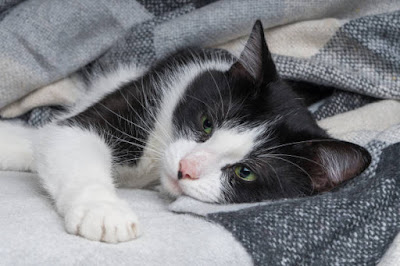Hepatic Lipidosis (Fatty Liver Disease) in Cats
Hepatic lipidosis is also known as fatty liver syndrome. This disease is unique to cats and is one of the most common liver diseases seen in cats. Hepatic lipidosis develops when a cat does not eat well for a period of time. The cause of why a cat may not eat for an extended period of time varies widely. This may induce medical as well as emotional reasons and at times there is no apparent reason. Because obese cats have larger fat stores to mobilize, they are predisposed to the development of fatty liver after shorter periods of anorexia.
The energy deficit that occurs when a cat is anorexic causes mobilization of fat stores in the body which then go to the liver. Because the liver is the organ that converts stored fat into usable energy, the liver becomes overwhelmed with this task and cannot perform normal daily metabolic functions.
 |
| How to prevent Fatty Liver in Cats |
Symptoms of fatty liver disease in cats
Signs of hepatic lipidosis can be really subtle, so it’s important to watch for clinical signs of the following:
- Decreased appetite or complete inappetance (i.e., anorexia)
- Hiding in unusual places (e.g., closet)
- Weakness or lethargy
- Icterus/jaundice (a yellow tinged color to the gums or skin, best seen on the ears and eyes)
- Drooling (often a sign of nausea)
- Vomiting
- Dehydration
- Small fecal clumps in the litter box (due to lack of eating)
- Constipation
- Collapse
- Weight loss
- Muscle wasting
- A weakened neck (the head hangs down more than usual with a chin tuck)
When untreated or in severe cases — signs of liver failure can include the following:
- Black tarry stool
- Bruising (abnormal clotting)
- Coma (from the liver poisons building up in the body)
- Abnormal behavior progressing to seizures
- Death
Diagnosis
Feline fatty liver disease is diagnosed by physical examination, clinical signs and changes in liver enzymes, and other values seen on laboratory tests. The liver will usually be enlarged on radiographs and there is a characteristic appearance on ultrasound of the liver that helps to confirm the diagnosis. On occasion, it may be necessary to differentiate hepatic lipidosis from another disease such as cancer, and a fine needle biopsy or larger biopsy of the cat’s liver is required.
Common Conditions That Cause or Increase a Cat’s Risk of Hepatic Lipidosis
While a cat can get “primary hepatic lipidosis,” or hepatic lipidosis that has no underlying cause, it’s more often the case that cats develop hepatic lipidosis “secondary” to some other underlying condition. And, in reality, it’s quite likely that many of the “primary” cases actually have an underlying cause, but it’s just not detected or diagnosed. Below are some of the more common conditions that can cause, or increase a cat’s chances of, a case of hepatic lipidosis:
- Diabetes
- Hyperthyroidism
- Pancreatitis
- Inflammatory bowel disease (IBD)
- Lymphoma
Treatment typically requires 24/7 care for several days to include the following:
One of the most important components of fatty liver disease treatment is nutritional support. Lack of nutrition allows the abnormal metabolic cycle (fat accumulation in the liver) to continue. In the past, a type of “forced feeding” was sometimes employed, entailing using a syringe to force liquefied food into the cat’s mouth. This technique is generally not recommended today, and may lead to food aversion.
- IV fluids to help treat dehydration
- Placement of a temporary feeding tube to provide adequate calories (this may be necessary for several weeks)
- Anti-vomiting medication
- Appetite stimulants
- Antibiotics
- Vitamin K (to help fix clotting problems if abnormal)
- Potentially plasma transfusions (if severe clotting problems are noted)
Prevention
- The best means of prevention for hepatic lipidosis is to remain vigilant in assessing a cat’s weight, feeding, and litterbox Cats that skip more than a few meals or experience significant declines in the amounts of food they are eating should be examined by a veterinarian. Also, any rapid weight loss, even if it initially seems desirable, should be a signal to seek veterinary attention.
